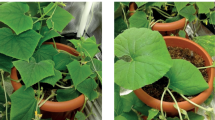Abstract
H2S emission from cucumber (Cucumis sativus L.) leaf discs supplied with L-cysteine in the dark is inhibited 80–90% by aminooxyacetic acid (AOA), an inhibitor of pyridoxal-phosphate dependent enzymes. Exposure to L-cysteine in the light enhanced the emission of H2S in response to this sulfur source. Turning off the light reduced the emission of H2S to the rate observed in continuous dark; turning on the light enhanced the emission of H2S to the rate observed in continuous light. Therefore, in the light H2S emission in response to L-cysteine becomes a partially light-dependent process. Treatment with cyanazine, an inhibitor of photosynthetic electron transport, reduced H2S emission in the light to the rate observed in continuous dark, but did not affect H2S emission in the dark. In leaf discs pre-exposed to L-cysteine in the light, treatment with cyanazine+ AOA inhibited the emission of H2S in response to L-cysteine completely. Therefore, only part of the H2S emitted in response to this sulfur source is derived from a light-independent, but pyridoxal-phosphate-dependent process; the balance of the H2S emitted is derived from a light-dependent process that can be inhibited by cyanazine. When cucumber leaf discs were supplied with a pulse of L-[35S]cysteine, radioactively labeled H2S was emitted in two waves, one during the first hour of exposure to L-cysteine, and a second after 3–4 h; unlabeled H2S, however, was emitted continuously. The second wave of emission of labeled H2S was not observed in pulse-chase experiments in which sulfate or cyanazine were added to the treatment solution after 3 h of exposure to L-cysteine, or when the lights was turned off. The labeling pattern of sulfur compounds inside cucumber cells supplied with a pulse of L-[35S]cysteine showed that the labeled H2S released from L-cysteine partially enters first the sulfite, then the sulfate pool of the cells. The radioactively labeled sulfate, however, is not incorporated into L-cysteine, but enters the H2S pool of the cells again. These observations are consistent with the idea of an intracellular sulfur cycle in plant cells. The L-cysteine taken up by the leaf discs seems to be desulfhydrated in a light-independent, but pyridoxal-phosphate-dependent process. The H2S synthesized this way may be partially released into the atmosphere; the other part of the H2S produced in response to L-cysteine may be oxidized to sulfite, then to sulfate, which is subsequently reduced via the light-depent sulfate assimilation pathway. In the presence of excess L-cysteine, synthesis of additional cysteine may be inhibited, and the sulfide moiety may be split off carrier bound sulfide to enter the H2S pool of the cells again. It is suggested that the function of this sulfur cycle may be regulation of the free cysteine pool.
Similar content being viewed by others
Abbreviations
- AOA:
-
aminooxyacetic acid
References
Bressan, R.A., LeCureux, L., Wilson, L.G., Filner, P., Baker, L.R. (1981) Inheritance of resistance to sulfur dioxide in cucumber. Hortic. Sci. 16, 332–333
Brewer, P.E., Arntzen, C.J., Slife, F.W. (1979) Effects of atrazine, cyanazine, and procyazine on the photochemical reactions of isolated chloroplasts. Weed Sci 27, 300–308
De Cormis, L. (1968) Degagement d'hydrogene sulfure par des plantes soumises a une atmosphère contenant de l'anhydride sulfureux. C.R. Acad Sci. Ser. D. 266, 683–685
De Cormis, L. (1969) Quelques aspects de l'absorption du soulfre par les plants soumises à une atmosphère contenant du SO2. In: Proc. I. Eur. conf. on the influence of air pollution on plants and animals, Wageningen, Netherlands, pp. 75–78. Centre for Agric. Publg. and Documentation, Wageningen
Ebert, E., Dumford, S.W. (1976) Effects of triazine herbicides on the physiology of plants. Residue Rev. 65, 1–103
Esterbauer, H., Grill, D. (1978) Seasonal variation of glutathione and glutathione reductase in needles of Picea abies. Plant Physiol. 61, 119–121
Giovanelli, J., Mudd, S.H., Datko, A.H. (1980) Sulfur amino acids in plants. In: The biochemistry of plants, vol. 5, pp. 453–505, Miflin, B.J., ed. Academic Press, New York London
Harrington, H.M., Smith, I.K. (1980) Cysteine metabolism in cultured tobacco cells. Plant Physiol. 65, 151–155
Kredich, N.M., Keenan, B.S., Foote, L.J. (1972) The purification and subunit structure of cysteine desulfhydrase from Salmonella typhimurium. J. Biol. Chem. 247, 7157–7162
Meister, A. (1965) Biochemistry of the amino acids, vol. 1. Academic Press, New York London
Raybould, C., Unsworth, M.H., Gregory, P.J. (1977) Sources of sulfur in rain collected below a wheat canopy. Nature (London) 267, 146–147
Rennenberg, H., Filner, P. (1982) Stimulation of H2S emission from pumpkin leaves by inhibition of glutathione synthesis. Plant Physiol. (in press)
Schmidt, A. (1979) Photosynthetic assimilation of sulfur compounds. In: Encyclopedia of plant physiology, N.S., vol. 6: Photosynthesis II, pp 481–496, Gibbs, M., Latzko, E., eds. Springer, Berlin Heidelberg New York
Sekiya, J., Schmidt, A., Rennenberg, H., Wilson, L.G., Filner, P. (1982a) Hydrogen sulfide emission by cucumber leaves in response to sulfate in light and dark. Phytochemistry (in press)
Sekiya, J., Wilson, L.G., Filner, P. (1982b) Resistance to injury by sulfur dioxide: correlation with its reduction to, and emission of hydrogen sulfide in Cucurbitaceae. Plant Physiol (in press)
Sekiya, J., Schmidt, A., Wilson, L.G., Filner, P. (1982c) Emission of hydrogen sulfide by leaf tissue in response to L-cysteine Plant Physiol. (in press)
Spaleny, J. (1977) Sulphate transformation to hydrogen sulphide in spruce seedlings. Plant Soil 48, 557–563
Wilson, L.G., Bressan, R.A., Filner, P. (1978) Light-dependent emission of hydrogen sulfide from plants. Plant Physiol. 61, 184–189
Winner, W.E., Smith, C.L., Koch, G.W., Mooney, H.A., Bewley, J.E., Krouse, H.R. (1981) H2S emission rates from plants and patterns of stable sulfur. Nature (London) 289, 672–674
Youle, R.J., Huang, A.H.C. (1981) Occurence of low molecular weight and high cysteine containing albumin storage proteins in oilseeds of diverse species. Am. J. Bot. 68, 44–48
Author information
Authors and Affiliations
Rights and permissions
About this article
Cite this article
Rennenberg, H., Sekija, J., Wilson, L.G. et al. Evidence for an intracellular sulfur cycle in cucumber leaves. Planta 154, 516–524 (1982). https://doi.org/10.1007/BF00402995
Received:
Accepted:
Issue Date:
DOI: https://doi.org/10.1007/BF00402995




